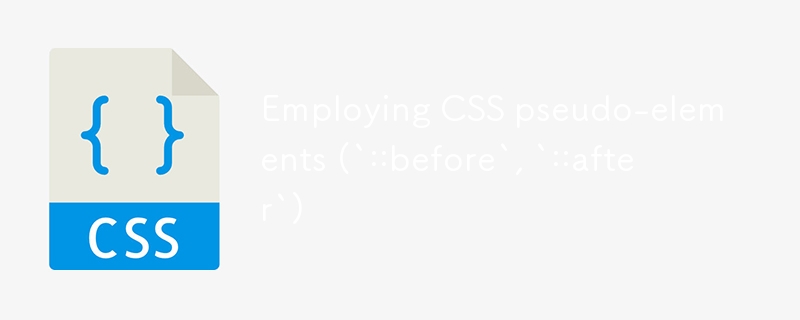
Course Introduction:Using HTML5's pattern attribute allows for convenient front-end input verification without JavaScript. 1. The basic usage is to write regular expressions into the pattern attribute of the input tag, which is used to restrict the content of the text input box; 2. Regular expressions should be added to ^ and $ to ensure full match and avoid misjudgment; 3. It can provide clearer prompt information with the title attribute, but the mobile side may not display it; 4. Common application scenarios include verification of mobile phone numbers, postal codes, passwords, license plate numbers, etc., but back-end verification is still required to ensure data security.
2025-07-04 comment 0 290

Course Introduction:To set the default value of the HTML input box, the value attribute is mainly used. The specific methods are as follows: 1. Add the value attribute to the tag, such as the default value will be displayed when the page is loaded; 2. Distinguish between value and placeholder, the former is the actual default value, and the latter is only the prompt text; 3. The default value can be dynamically modified through JavaScript, such as using document.querySelector("input[name='username']").value="NewDefault"; to implement update operations in interactive logic.
2025-07-09 comment 0 209

Course Introduction:The pattern attribute is a regular expression tool used for form verification in HTML5. It allows developers to restrict input formats through regularity. 1. It is valid only for text class input; 2. Regularity does not require anchor points, and case and escape need to be manually processed; 3. Common formats such as mobile phone numbers and passwords have corresponding expressions; 4. The browser compatibility is good but the prompt style is not uniform; 5. Prompt information can be provided with the title attribute; 6. Some mobile environments need to be tested or supplemented with JS verification. When using it, you should adjust the rules according to business needs and pay attention to their limitations. If necessary, combine JavaScript to implement more complex verification logic.
2025-07-08 comment 0 940

Course Introduction:Use CSS pseudo-elements (::before and ::after) to insert content and enhance visual effects without modifying HTML. 1. The basic usage is to add text or symbols through the content attribute, such as inserting red prompt text before the paragraph; 2. Common techniques include inserting quotes, arrows, icon fonts and implementing small triangles and other UI details; 3. You can use to match positioning and styles to achieve decorative effects, such as small triangles in the prompt box, button hovering effect, etc.; 4. It was used to clear floats, such as .clearfix::after to solve the floating collapse problem; 5. Notes include: the content must exist, the pseudo-element defaults to inline, and cannot be operated by JS, and is not suitable for placing important content, because of its influence.
2025-07-06 comment 0 870

Course Introduction:The title attribute can be applied to almost all HTML tags, such as,,,,,, etc., and is used to display prompt information when hovering. Common uses include explaining the purpose of the link, supplementing the picture description, prompting the input format, explaining the button function, or layout block function. When using it, you should pay attention to: 1. It should not be relied on to transmit key information, because the mobile terminal does not support hover and the screen reader compatibility is poor; 2. The content should be short to avoid lengthy affecting the experience; 3. Avoid duplication with existing text; 4. The style is limited and the appearance cannot be customized. Compared with other prompt methods, the alt attribute pays more attention to accessibility, aria-label or aria-describedby is more suitable for assistive technologies, while a custom tooltip provides stronger interactivity.
2025-07-16 comment 0 674

Course Elementary 13770
Course Introduction:Scala Tutorial Scala is a multi-paradigm programming language, designed to integrate various features of object-oriented programming and functional programming.

Course Elementary 82280
Course Introduction:"CSS Online Manual" is the official CSS online reference manual. This CSS online development manual contains various CSS properties, definitions, usage methods, example operations, etc. It is an indispensable online query manual for WEB programming learners and developers! CSS: Cascading Style Sheets (English full name: Cascading Style Sheets) is an application used to express HTML (Standard Universal Markup Language).

Course Elementary 13144
Course Introduction:SVG is a markup language for vector graphics in HTML5. It maintains powerful drawing capabilities and at the same time has a very high-end interface to operate graphics by directly operating Dom nodes. This "SVG Tutorial" is intended to allow students to master the SVG language and some of its corresponding APIs, combined with the knowledge of 2D drawing, so that students can render and control complex graphics on the page.

Course Elementary 24589
Course Introduction:In the "AngularJS Chinese Reference Manual", AngularJS extends HTML with new attributes and expressions. AngularJS can build a single page application (SPAs: Single Page Applications). AngularJS is very easy to learn.

Course Elementary 27446
Course Introduction:Go is a new language, a concurrent, garbage-collected, fast-compiled language. It can compile a large Go program in a few seconds on a single computer. Go provides a model for software construction that makes dependency analysis easier and avoids most C-style include files and library headers. Go is a statically typed language, and its type system has no hierarchy. Therefore users do not need to spend time defining relationships between types, which feels more lightweight than typical object-oriented languages. Go is a completely garbage-collected language and provides basic support for concurrent execution and communication. By its design, Go is intended to provide a method for constructing system software on multi-core machines.
Overwriting block file from vendor module, changes not showing
2024-01-16 21:10:24 0 1 505
Laravel Modal does not return data
2024-03-29 10:31:31 0 1 591
Can I use the automatic generation module of thinkphp5 in Windows 7 system? How to configure and use
2017-10-10 17:04:14 0 2 1389
2017-10-10 19:25:59 0 4 2943
To use mcrypt_get_key_size() in php study, how to enable mcrypt_
2017-10-10 19:47:34 0 1 1172